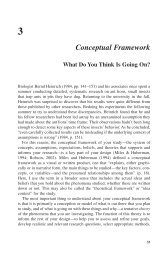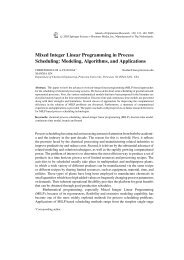Qualitative Research Basics: A Guide for Engineering Educators
Qualitative Research Basics: A Guide for Engineering Educators
Qualitative Research Basics: A Guide for Engineering Educators
Create successful ePaper yourself
Turn your PDF publications into a flip-book with our unique Google optimized e-Paper software.
arbiters/mediators of social/cultural knowledge?” Those being observed also bring<br />
differing perspectives, based on gender, ethnicity, class, or positions of power. Thus,<br />
observation, particularly in the area of ethnography, is coming to be seen as a<br />
collaboration between the observer and the observed. The result is a dialogue between the<br />
two that results in a shared understanding of the setting. Ultimately, Angrosino suggests<br />
that, “It might be useful to shift from a concentration on observation as a ‘method’ per se<br />
to a perspective that emphasizes observation as a context <strong>for</strong> interaction among those<br />
involved in the research collaboration” (p. 732).<br />
Documents and Materials<br />
In many ways use of documents and other materials is the “<strong>for</strong>gotten” data source <strong>for</strong><br />
social sciences research. Yet many scholars find that the paper trails, as well as the<br />
artifacts produced by people, are highly in<strong>for</strong>mative to their studies. While documents<br />
consist of a variety of print (hard copy or digital) sources, other materials that may be<br />
examined include photographs, visual art, music, instruments, clothing, or other products<br />
that can help to tell the story.<br />
Documents<br />
McCulloch (2004) traces the history of document analysis, noting that the use of<br />
documents reached its height in the mid-20 th century, but has been in decline in favor of<br />
interviews and observations since then. Nevertheless, there are instances of documents<br />
and materials being used in engineering education research: <strong>for</strong> example, Wankat's<br />
(2005) use of Web-based in<strong>for</strong>mation on design contest winners and Jarosz and Busch-<br />
Vishniac's (2006) examination of syllabi to identify the current body of knowledge in<br />
mechanical engineering.<br />
Documents can be used in many ways. Punch (1998) provides four ways in which<br />
documents can be examined:<br />
• Social production: What are the social, historical, or cultural conditions that led to<br />
the production of the document?<br />
• Social organization: What in<strong>for</strong>mation is intended to be conveyed by the<br />
document? How was it intended to be used?<br />
• Meaning: What is the direct, surface meaning being conveyed by the document?<br />
What are the deeper meanings on which the surface meanings rely?<br />
• Alternate epistemological perspectives: Use of critical or postmodern perspectives<br />
to examine documents in other ways.<br />
Thus, documents can be used in many different ways. They can provide historical<br />
in<strong>for</strong>mation that tells about how certain issues were perceived or dealt with in the past.<br />
As in the examples cited above, they can also provide a means <strong>for</strong> understanding current<br />
issues by collating in<strong>for</strong>mation across several institutions. An alternate approach is<br />
through semiotics and textual analysis, in which the focus is not only the content of the<br />
document, but also the language used and the organization of the document (Punch,<br />
1998). These approaches can be used to examine the underlying structures from which<br />
32
















